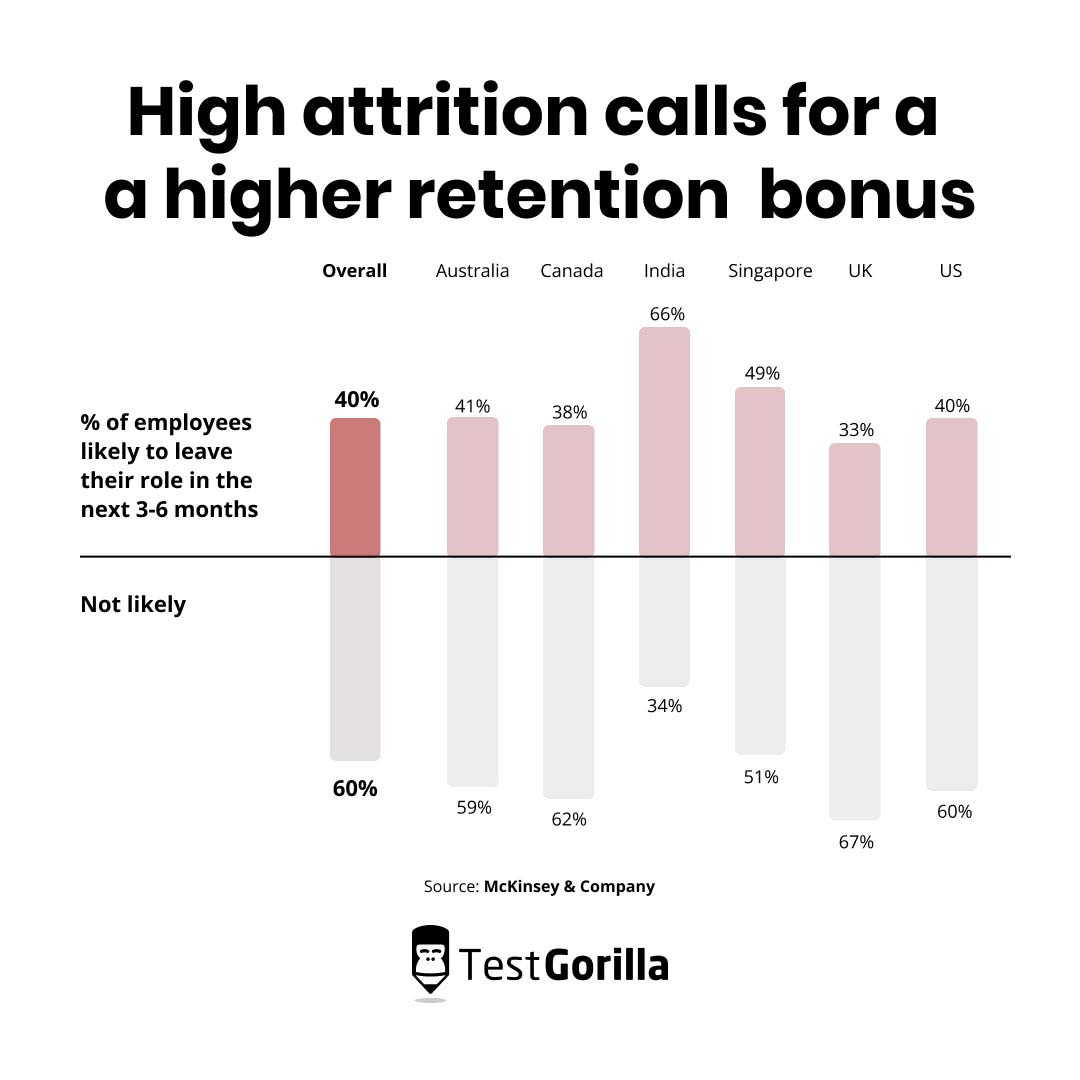The search for talent is one of the biggest problems facing any HR manager.
With one-third of leaders claiming that finding talent is their biggest managerial challenge, it often feels like you end up in the dust of competitors who snatch up great candidates before you even have a chance.
So, how do you get a leg up on those competitors?
The key is to build and expand your talent pool – a database of qualified candidates who you can tap into for future job openings.
A smart talent pool strategy lets you proactively engage with and recruit top candidates to ensure you’re the first company they’d want to sign on with.
However, building a talent pool entails more than adding candidates to a database. The most effective talent pool usage involves regular updating, candidate nurturing, and talent assessment to ensure your pool focuses on the skills your company needs.
Let’s learn more about what a talent pool is, how to create a talent pool, and how to expand and refine this pool to reap the most of its benefits.
Table of contents
- What is a talent pool?
- Why are talent pools important to organizations and HR departments?
- How to build a talent pool: A 5-step process
- 7 proven best practices for building and expanding your talent pool
- 3 examples of companies succeeding with talent pools
- Turn your talent pool into a colorful ocean using talent assessments
What is a talent pool?
A talent pool is a repository of qualified candidates who have shown interest in your organization and whose skills would be well-suited for roles within your company.
As opposed to a talent pipeline, which refers to candidates actively in the process of an application, the talent pool definition focuses primarily on passive candidates. You can target and foster a relationship with these candidates to help nudge them from the talent pool into the talent pipeline.
In the past, talent pools had been managed with physical spreadsheets or through Excel, but technology has streamlined the process significantly with tools like applicant tracking software, making the challenge of building a talent pool much more time- and cost-effective.
What type of candidates fit into a talent pool?
Although a talent pool encompasses a vast range of candidates, they typically fall into three categories:
Previous candidates who fell just short in the application process but who you want to keep in your database because of their impressive skill set or potential culture add
Talent who has not directly applied yet but who has shown an interest in your organization and who you believe would be a good fit
Former employees who you would consider rehiring, as well as current employees with the potential to move into new roles
On that last point, it’s important to remember your talent pool is made up of not only external candidates but also internal ones.
Your internal workforce possesses a deep reservoir of talent, so be sure to include them in your talent pool to get the full picture of the skills at your disposal.
This also helps promote internal mobility, building an overall more agile talent pool.
Why are talent pools important to organizations and HR departments?
You may be thinking to yourself, “Hiring is already enough of a hassle. Why do I need to complicate it further with managing a talent pool?” Actually, it’s the opposite. Building a talent pool streamlines and maximizes your hiring process.
Here are a few key benefits of creating a talent pool:
Improves diversity and quality of hire
Reduces time to hire
Turns passive candidates into active ones
Improves diversity and quality of hire
A broad and diverse talent pool gives you far more options when you need to seek out candidates for a given role.
A talent pool informed with skills-based hiring practices has been shown to give employers a 91% boost to their workplace diversity.
And diversity in the workplace leads to more productive, adaptable, and innovative teams.
But it’s not only about quantity; by properly monitoring your talent pool, you know what skills you have available, and you can target only candidates who possess the skills to excel at the given role.
The end result is a more accurate hiring process with fewer bad hires.
Reduces time to hire
Fostering a pool of talent is a more proactive way to go about your hiring process.
In the US, it takes an average of 36 days to fill a position – a long time for your team to grapple with missing a key team member.[2]
Rather than scrambling to collect job candidates when a role opens up, you have a repository of qualified applicants ready to tap into as necessary.
This lets you skip a lot of the preliminary groundwork when it comes to sourcing applicants for a freshly vacated role. Combined with the improved quality of candidates we spoke about above, you significantly cut down on your time to hire.
Turns passive candidates into active ones
One difficulty many organizations face in their hiring process is turning valuable passive candidates into active ones who are readily seeking a job within your company.
With 40% of workers saying they’re likely to leave their jobs in the near future, it’s crucial to pave a pathway for activating this talent source.
A talent pool helps solve this by giving you a way to target and nurture these candidates to eventually funnel them into your talent pipeline.
Once they’re within your database, you can send them personalized content like emails and newsletters to show why your company is the perfect fit for them, gently nudging them toward applying with you.
How to build a talent pool: A 5-step process
To fully access all the benefits of a talent pool, you need to have a plan for how you’re going to construct your pool.
These five steps help you build a deep and focused talent pool to draw from whenever you need top talent.
Step | Explanation |
1. Establish criteria | Look at organizational needs to determine what type of candidates you should seek out for your talent pool |
2. Source | Determine where to get your talent from, such as a job board or less traditional source like college campuses |
3. Segment | Organize your talent pool within a database to quickly access candidates based on certain skills |
4. Nurture and engage | Foster a relationship with the talent in your pool to encourage them toward your talent pipeline |
5. Update | Regularly update your talent pool based on current company needs and candidate preferences |
1. Establish criteria
The first step in constructing your talent pool is to decide who you should actually add to it.
Although you want to aim for as broad a pool as possible, you shouldn’t add anyone and everyone you come across. Doing so makes the hiring process more convoluted and difficult, defeating the purpose.
Consider your organizational needs. What roles are you expecting to need to hire for in the future? What departments are expanding that may need more help? What areas are you strong in, and what areas are not quite where you want them to be?
A skills gap analysis can be a huge help here. Using talent assessments, this analysis gives you an objective, high-level view of the skills within your organization so you can easily see any existing gaps you need to fill.
2. Source
Next, you need to decide where you’ll be drawing your pool of talent from. This is an important step since focusing your efforts on specific sources of talent helps you construct a more effective campaign to target those sources.
Traditionally, good sources are places such as job boards or career fairs. However, less common sources can give you an edge in building your talent pool. Consider avenues like campus recruitment or social media, especially if you’re looking for younger talent to grow and develop within your company.
3. Segment
Segmenting your talent pool refers to organizing talent within your database based on their experience, skills, career goals, and other individual factors.
Segmenting is a crucial part of talent management. It makes the process much easier on you by giving you a way to quickly seek out candidates based on specific criteria.
Suppose you need to hire a software engineer who’s knowledgeable in C++. Segmenting lets you search specifically for past candidates who, for example, hit a certain score on the C++ Coding test when they originally applied.
Or, if you’re hiring for a high-level position, you could segment based on career goals, making it easier to see an exec talent pool of people fit for leadership.
Segmenting also helps personalize your content toward candidates to build a relationship with them, which leads to our next point…
4. Nurture and engage
One of the best uses of a talent pool is for candidate nurturing – fostering a relationship with high-quality candidates to encourage them to apply to your company.
Once you’ve properly sourced and segmented your talent pool, you can send targeted content to candidates based on their career and development goals.
One common sentiment among job seekers is that “talent pool” is simply another word for “waitlist,” as Reddit user Worthlesh echoes:
This sentiment persists because many companies put candidates in their talent pool but never make the effort to nurture or engage with them. Without this outreach, they make their candidates feel totally unvalued.
Putting in the effort to engage with your talent pool on an individual level lets them know you respect them as people, and it helps to show your company culture to them.
5. Update
Finally, strive to keep your talent pool as up-to-date as possible, and continuously refine and develop your processes based on what has worked and what hasn’t.
A stale talent pool is not going to do you or your candidates any good. Maybe a candidate applied to you three years ago with an interest in a project manager position, but since then, their goals have shifted toward financial management. Sending them project management material is unlikely to engage them.
Regularly check in with top candidates to see if their goals have changed. Additionally, keep your talent pool criteria updated based on current organizational needs and trim out previous applicants who no longer align with those needs.
7 proven best practices for building and expanding your talent pool
Along with the steps we’ve outlined above, here are seven proven tips for making the most of your talent pool.
These practices help you further broaden your pool and effortlessly manage the sea of talent at your disposal.
Building and expanding your talent pool: A summary
Practice | Summary |
1. Drop unnecessary job requirements | Focus on expertise rather than experience by doing away with resume requirements |
2. Switch to skills-based hiring | Objectify your recruitment process using talent assessments to fill your pool with skilled candidates |
3. Utilize an applicant tracking system (ATS) | Organize candidate data in an ATS for easy searching and analysis |
4. Diversify your pool | Broaden your pool by looking at nontraditional job candidates, such as boomerang employees |
5. Tap into internal talent | Ensure existing employees are included in your talent pool through the use of an internal talent marketplace |
6. Build your employer branding | Draw top talent into your pool by building a strong employer brand that focuses on your company culture |
7. Regularly evaluate your talent pool | Gauge your talent pool initiatives regularly to focus on current company needs and which recruiting strategies are most fruitful |
1. Drop unnecessary job requirements
Degrees and years of experience are valuable, but they don’t always equal relevant expertise or a perfect fit with your company.
Remember, the goal of a talent pool is to have a tool of talented people – and talent is difficult to gauge through subjective measures like resumes. You could even fall victim to a resume horror story.
To expand your talent pool, you need to prioritize other important things, like skills testing and making sure your application process isn’t too long and repetitive. A lengthy hiring process (or a lack of clarity about how long hiring would take) impairs the candidate experience, and you risk losing top candidates.
So, how do you zero in on expertise?
Drop the excess weight discouraging applicants, like a three-hour application process
Rework your job descriptions to use inclusive language and reflect what’s integral to each role, like testing for English proficiency instead of inviting “native speakers only”
Reconsider requirements related to a specific degree or number of years of experience
Everyone’s path is different. Always choose to test for the right skills and competencies and focus on your intended result rather than the common method of achieving it.
2. Switch to skills-based hiring
A bias-free, skills-based hiring process opens the door to a wider variety of talent, such as:
People switching careers and people with gaps in their resume
People with the right skills but no formal training (for example, self-taught developers)
Candidates from disadvantaged backgrounds
So, what does skills-based hiring look like in real life?
For example, Accenture prioritizes learning agility. They hire based on relevant skills and potential.
To include more women in tech, the company went to liberal arts schools and hired talent with excellent critical thinking skills, then trained them in tech.
That way, they accessed talent that would have otherwise remained hidden.
But how do you spot the right characteristics and abilities in potential candidates?
You can accomplish this through multi-measure skills testing. Use skills testing as part of the holistic hiring process for a clearer picture not only of your candidate’s hard skills, but also things like their personality and judgment.
Even if you end up hiring someone else, keep applicants’ test results in your database – this way, later, you’ll be able to instantly identify strong candidates in your talent pool. You should notify candidates if you do this and potentially ask for their permission to store their results and other data.
3. Utilize an applicant tracking system
Technology makes the construction and management of a talent pool much more digestible, and no technology is more useful here than an applicant tracking system, or ATS.
An ATS helps with nearly every step of the process outlined above. This talent pool software stores and organizes applicant data so you can easily access it at any time. Depending on the ATS you opt for, you can leverage various other features in building and engaging your talent, including:
Automated candidate sourcing
External job board posting
Data analytics regarding the effectiveness of your campaigns
Ease of collaboration for HR teams
Integration with other recruitment tools
With many options at your disposal, it’s important to choose the right ATS for your needs.
For example, a smaller company strapped for time might seek an ATS that can assist with much of the recruitment and onboarding process for them and help provide a good candidate experience, while a larger company might want one more focused on segmentation and automation.
Remember, though, not to rely on technology and automation for steps like engaging directly with candidates because this can lead to your talent feeling undervalued.
4. Diversify your pool
One of the best ways to build diversity in your workforce is to start at the source and diversify your talent pool.
It is possible to luck out in building your talent pool and succeed with only one channel of talent – but in this case, much of your talent is likely to fit into the same mold, leading to a homogenous company culture lacking innovation.
Instead, you should aim to branch out, accessing several sources of talent to promote diversity and culture add in your company.
Along with the traditional job boards and referrals, consider looking at nontraditional hires:
Boomerang employees: These former employees already know your company culture and processes and can return with fresh knowledge acquired from their new experiences.
Fair chance hiring: A large portion of the US population has a criminal record; excluding these candidates from your search greatly stunts your talent pool. These candidates even bring unique benefits that can be a huge boon to your organization.
Employees returning to work after hiatus: Excluding candidates simply because they have a gap on their resume is another surefire way to miss out on stellar talent. Be sure to include these job seekers in your pool and include processes to help them integrate into your workforce once they’re hired.
5. Tap into internal talent
Along with external talent, don’t forget to include your internal talent in your pool.
Modern employees place huge importance on upskilling and development opportunities, and they want to know their employer is invested in their growth. Putting them in your talent pool lets them know they’re valued, making them more likely to stay and be engaged with their work.
The best way to do this is by building an internal talent marketplace. This marketplace lets employees input their skills and goals for the HR team to see, enabling them to help their employees reach their career development goals.
It also promotes internal mobility by showing employees job opportunities and vacancies within the company, especially those most suited to their interests.
Many ATS programs also have integrations for building an internal talent marketplace, so be sure to keep an eye out for this feature when deciding on an ATS for your company.
6. Build your employer branding
When it comes to attracting top talent to your company, strong employer branding is a non-negotiable.
Consider that 60% of job seekers choose a company based on its values. If you aren’t building and showing off your branding, you’re significantly hampering your talent pool recruitment.
That’s not even mentioning the wide array of benefits employer branding offers beyond your talent pool, such as improved retention rates and fewer bad hires.
The first step in building your employer branding is to invest in a good company culture – after all, it’s the foundation upon which everything else relies. From there, ingrain your values in places like your company website and career portal so they’re clear for interested talent.
7. Regularly evaluate your talent pool
Along with keeping the data in your talent pool fresh and updated, you also want to regularly evaluate the effectiveness of your talent pool.
Continuous talent pool assessment helps you focus on the initiatives that yield the most success, maximizing your recruitment efficiency.
Look at the data coming from your pool to see what has worked for you and what hasn’t. For example, maybe you notice most of your successful candidates come from LinkedIn – so you should invest more effort in recruiting from there.
This sort of analysis is known as data driven recruiting. It’s a method of recruitment that focuses on hard, objective data to inform decisions, eliminating much of the bias that tends to creep into the recruitment process.
3 examples of companies succeeding with talent pools
So, what does a good talent pool look like in practice?
For inspiration, here are three successful talent pool examples from real-world companies.
McKinsey
McKinsey gives us a unique example of talent pool usage with its Alumni program. This program caters to former employees who have since moved on from the company, staying in touch and providing them with career services and other resources.
The company already knows these former employees are quality candidates, so it recognizes the potential benefits of being able to re-engage these workers as boomerang employees.
Even if these employees do not intend to return, providing them with these resources is a way to show them that McKinsey values the work they put in for the company. This keeps up a friendly relationship that contributes to its strong employer branding.
Ryte
Ryte focuses on an awesome candidate experience for its potential applicants.
Its career site enshrines all the company values and benefits, many of which are key things top talent is looking for in the modern day, such as the importance of company culture, servant leadership, and the opportunity to develop one’s career.
The company also gives a clear map of what the application process looks like so no candidates are left in the dark. Finally, it gives job seekers a clear call to action if they’d like to join the organization’s talent pool.
This focus on transparency lets applicants know what kind of company Ryte is, helping to draw in the best talent to its pool.
Google aims to catch a wide breadth of talent in its pool, pursuing multiple different talent channels to build diversity in its approach.
For example, it goes to job fairs to target younger talent with an eye toward the future while also recruiting through online job boards to find more veteran workers.
This is especially important when you consider the sector Google works in. It needs to hire a mix of knowledgeable, seasoned employees and fresh faces with a finger on the pulse of current trends.
To cap things off, Google puts the utmost importance on providing development and upskilling opportunities for its talent pool. This helps nudge them toward the talent pipeline, turning passive candidates into active applicants.
Turn your talent pool into a colorful ocean using talent assessments
Building a talent pool is more than constructing a simple “waitlist” of your applicants – it’s about monitoring the talent within your company and actively engaging with them to turn them from passive candidates into active ones.
To construct a stellar talent pool, aim to diversify and bring talent assessments into your process to ensure you’re populating the pool with the right skills to do the job.
Once the construction is done, the next step is to focus on talent pool management to make the most out of what you’ve built.
To help build a thoroughly diverse talent pool, use the Culture Add test to seek out candidates who bring unique perspectives to your company.
Sources
Keller, Scott. (November 24, 2017). “Attracting and retaining the right talent”. McKinsey. Retrieved November 27, 2023. https://www.mckinsey.com/capabilities/people-and-organizational-performance/our-insights/attracting-and-retaining-the-right-talent
“SHRM Customized Talent Acquisition Benchmarking Report”. (2017). SHRM. Retrieved November 27, 2023. https://www.shrm.org/ResourcesAndTools/business-solutions/Documents/Talent-Acquisition-Report-All-Industries-All-FTEs.pdf
Related posts
Hire the best candidates with TestGorilla.
Create pre-employment assessments in minutes to screen candidates, save time, and hire the best talent.
Latest posts
The best advice in pre-employment testing, in your inbox.
No spam. Unsubscribe at any time.

Hire the best. No bias. No stress.
Our screening tests identify the best candidates and make your hiring decisions faster, easier, and bias-free.
Free resources
Anti-cheating checklist
This checklist covers key features you should look for when choosing a skills testing platform
Onboarding checklist
This resource will help you develop an onboarding checklist for new hires.
How to find candidates with strong attention to detail
How to assess your candidates' attention to detail.
How to get HR certified
Learn how to get human resources certified through HRCI or SHRM.
Improve quality of hire
Learn how you can improve the level of talent at your company.
Case study: How CapitalT reduces hiring bias
Learn how CapitalT reduced hiring bias with online skills assessments.
Resume screening guide
Learn how to make the resume process more efficient and more effective.
Important recruitment metrics
Improve your hiring strategy with these 7 critical recruitment metrics.
Case study: How Sukhi reduces shortlisting time
Learn how Sukhi decreased time spent reviewing resumes by 83%!
12 pre-employment testing hacks
Hire more efficiently with these hacks that 99% of recruiters aren't using.
The benefits of diversity
Make a business case for diversity and inclusion initiatives with this data.






























